#aluette
Text

big dick is back in town
23 notes
·
View notes
Photo

Edgewave Fest
[7 of 9]
#zlantina#chetana#dixon#aj#olly#kitani#aluette#simpodia#simblr#edgewavefest#edgewavefest2023#the sims 4#sims 4#ts4#edgewave2023#edgewave 2023
21 notes
·
View notes
Photo

I draw my ffxiv char way too little
33 notes
·
View notes
Text
Day 5: Pragma
A committed, long-lasting love and no love is longer lasting than that of two Viera, a race that lives for hundreds of years.
I'm falling a little behind but I want to keep going!
Quill and Aluette sat side by side in front of the fireplace, holding each other's aging hands. Today was their 150th wedding anniversary. All of their friends have long since returned to the aetherial sea, even Hohoka who many thought would never die. Still, they had each other and their family.
Every year, now becoming every day, Quill thanked the universe for his form as a Viera, the form that allowed him to live alongside his love for this long. Their children, their grandchildren, and their friend's grandchildren all adventured around the star, doing the work they once did. The two freedom fighter lovers had long since retired to the keeping of their free company house, entrusted to them by their Lalafell friend before her passing. They would spend whatever time was left to them - a hundred more years, maybe 200 more - in peace and love.
2 notes
·
View notes
Text
i love it when youtube comments are like “well my theory is (extremely obvious point the video was clearly trying to make)”
#'my interpretation is that the girl in queen aluett actually killed all her servants for real and recreated the events but with a good end#yes well done thats literally what happens in the video it is pretty cut and dry that thats exactly what happened
3 notes
·
View notes
Text
The more I listen to LeaF the more I am annoyed she doesnt put more of her songs on Spotify. Come on your stuff is already hard to track down dont make it worse
#sobs i have one wish and that is queen aluett on a service that i dont need to fistfight every time ti want to listen to it#and marenol but i guess that song has enough issues with being yoted to the shadow realm already for its contents. but it fucks#i miss the days when i started listening to hardcore music and she wasnt my jam. please brain return to that state asap#and yeah technically she makes her stuff free to download on her twitter but like... i like her stuff i wanna support her by listening#and also i do not want to fight my windows computer and apple phone incompatibility too much lol#erika.txt
0 notes
Text
Queen Aluett -女王アルエット-
youtube
⚠️ Flashing ⚠️
If you're craving for a fairytale feverdream with a touch of the macabre, I raise you Queen Aluett, a collaboration between LeaF, Optie and toconiwa.
I think it's all done digitally, mixing 3D modeling with cute 2D anime illustrations, and Optie did an amazing job cementing the paper and practical effects look. Also fun fact, you can decipher the in-universe language into English, but you really don't need to to enjoy this fantastical ride.
0 notes
Text
Queen Aluett
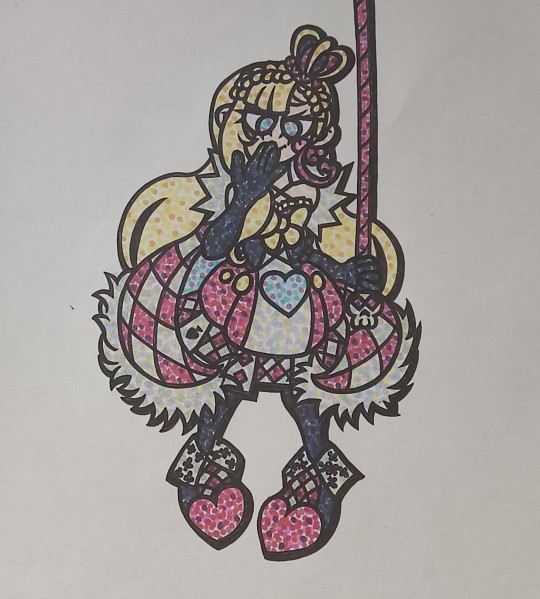
1 note
·
View note
Text
Playing Card Master Infodump
Ok gang, let's talk about playing cards again.
I’m going to try and get through this as systematically as possible but I will inevitably end up repeating myself due to the interconnected nature of the whole thing. Also I’ll try putting in subheadings to make it more readable. Let’s crack on!
Mameluk Playing Cards
I mentioned in my first post that European playing cards are based on ones from Mameluk Egypt, so let’s see if we can find some historical examples.

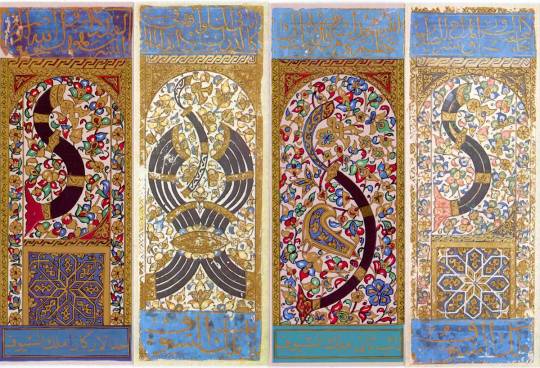
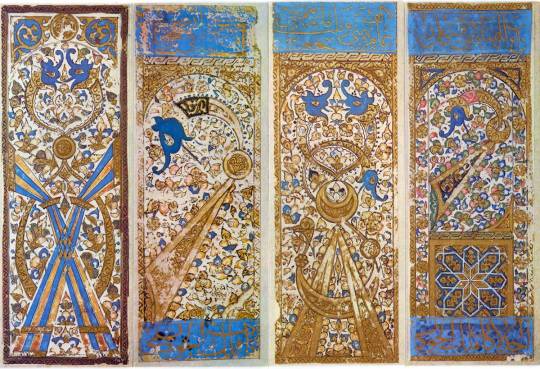

From the Topkapu Sarayi Museum in Istanbul, an amazingly preserved set of Mameluk playing cards depicting the four suits
These cards are a perfect starting point. Dating from the 15th or 16th century, we’ll be seeing their influence percolate throughout playing card design throughout Europe. Here we see the suits that will directly influence Spanish and Italian playing cards: coins, cups, swords, and polo batons (a common sport of the ruling class). The court cards are King-Lieutenant-Second Lieutenant, the deck would’ve contained 52 cards (1-10 plus three court cards), and the illustrations are rich in detail and heavy with Islamic calligraphy. We will be tracing the evolution of European cards back to these ones as we go along, so it’s important to have an example of where it all started.
Spanish Patterns
The Islamic influence in southern Spain makes it the perfect entry point for playing cards to arrive in European material culture around the late 14th century. Spanish patterns follow the same suits as Mameluk ones (coins, cups, swords, and staffs), but a deck would contain only 48 cards, numbers 1-9 and three court cards. The court cards follow the Mameluk rankings but with a European twist, making it King-Knight-Page. Swords in Spanish cards are depicted straight, as opposed to Italian swords which are curved.

Old Catalan / Spanish National Pattern, modern day

Piacentine Pattern, found in Italy in Bourbon ruled Piacenza, shows remarked Spanish influence yet is the only Spanish pattern regularly sold today to feature reversible court cards
Some syncretism would occur with the intermediary Franco-Spanish pattern, as Spanish cards would arrive in France prior to the establishment of the French standard patterns. The use of Spanish suited cards continues in areas such as Brittany and the Vendee through the game of Aluette, however the original Franco-Spanish pattern is now extinct. These decks would also consist of 48 cards: 1-9 and three court cards, King-Knight-Page (Roi-Cavalier-Valet). The use of these patterns would directly influence French patterns to come
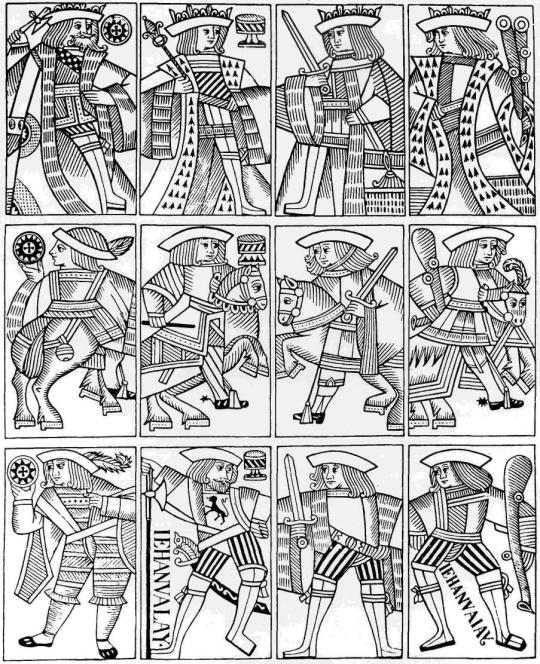
The court cards in the Franco-Spanish pattern showing Spanish suits
French Patterns
French patterns would begin with Spanish ones around the 14th Century, and would mesh with Germanic ones to produce something we would start to recognise as the Anglo-American pattern. The French suits (Hearts, Clovers (Clubs), Tiles (Diamonds), and Pikes (Spades)) are based on the Germanic suits (Hearts, Acorns, Bells, and Leaves respectively), however for a brief period a suit of Crescents was used instead of Tiles.
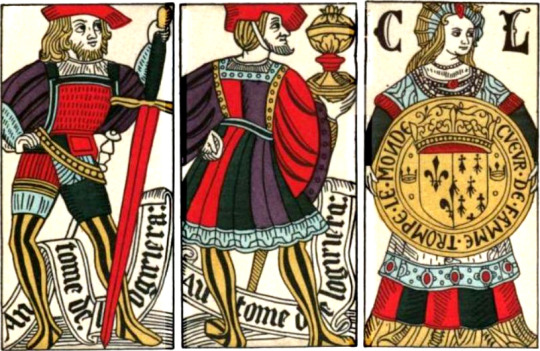
Cards celebrating the union of the kingdoms of Britanny and France, 1500, show the Spanish suits
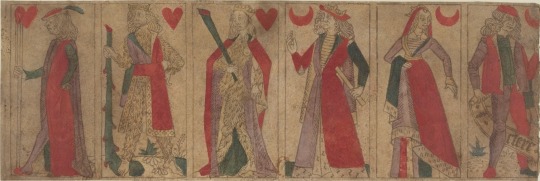
An example of the short-lived Crescents suit, Lyon, late 15th century
The majority of Italian, Spanish, and Germanic patterns follow the Mameluk tradition of all male court cards, which causes French patterns to stand out with the inclusion of Queens in place of the Knights. Queens had appeared in decks in both Italy and Germany in the 15th century, but had mostly been dropped in non-tarot decks. The inclusion of Queens, however, continued in France where their inclusion replaced the Cavalier (Knight) with the Dame (Queen). The naming convention of Dame for Queen will also be seen in Germanic patterns.
The Paris pattern, as distinct from Anglo-American or Hamburg patterns (about which more anon), is unique in that each of the court cards reference a historical or biblical figure, and are so named even to this day in the portrait officiel pattern (a deck of 32 cards, however sometimes printed in 52-card deck variants). As an example, the Kings of the Paris pattern refer to Charlemagne (Hearts), Alexander the Great (Clovers), Julius Caesar (Tiles), and King David (Pikes). The use of Julius Caesar as the historical figure associated with the King of Tiles, and most known in the past by his depiction on Roman coins in profile, might explain why in the later Anglo-American pattern the King of Diamonds is the only King to be depicted standing in profile.
Belgian pattern cards are similar to Paris (portrait officiel) decks and likewise come in 32-card and 52 card variants.
Germanic patterns
The closest pattern to connect Germanic decks to French ones is the Hamburg pattern, which would directly influence the North German or Berlin pattern. Taking the suits that we know today (hearts, clubs, diamonds, spades) and beginning production in the early 19th century, a clear link to the Paris (portraits officiel) pattern is shown in the depiction of the King of Spades holding the Harp of King David, a reference to the association of King David with the suit of Pikes (Spades) in the Paris pattern, and the laurel wreath under the crown of the King of Diamonds (Julius Caesar, King of Tiles). Germanic patterns closely associated with the French patterns name the court cards as King-Lady-Farmer (König-Dame-Bauer)
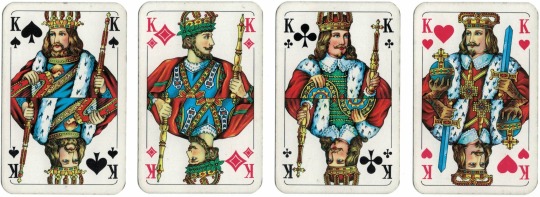
The Kings from the North German pattern showing links to the Paris (portrait officiel) pattern conventions
Germanic pattern playing cards, however also predate the suits used in French patterns and had a direct influence on them. The Germanic suits of Hearts, Acorns, Bells, and Leaves became standard around 1450, where upon it would directly influence the French suits and finally the modern Anglo-American system of Hearts, Clubs, Diamonds, and Spades. Many packs using this system contain only 32 or 36 cards, as is appropriate for the kinds of games played in the areas where they are common, and the court cards are typical established as King-Over-Under (König-Ober Knabe-Unter Knabe) in the Mameluk style of a leader and two ranks of soldier. The Ace in Germanic suits is really, and was referred to in the past as, a Deuce (Daus in German), which is why the Ace in these decks, the highest card in many regional games, actually exhibits two suit symbols rather than one. In the William Tell pattern deck, the four Deuces represent the four seasons of the year, however this is not typical across Germanic decks, which typically depicted a boar or sow in older decks, a tradition that continues today only on the Deuce of Bells.
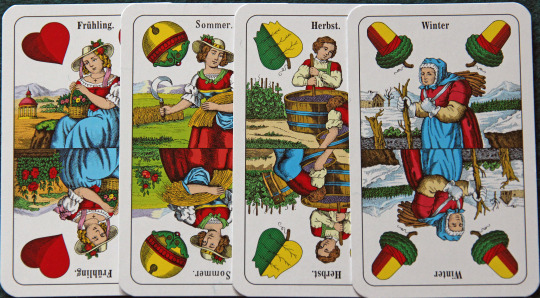
The Deuces (Daus) of Germanic decks
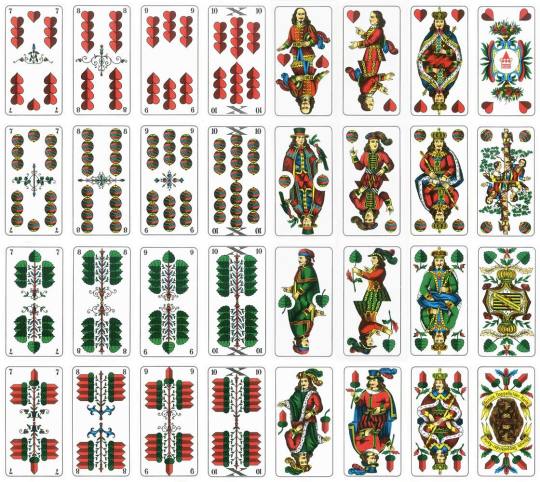
Saxon pattern

Polish-Silesian pattern for the game of Skat

Altenburg Doppelkopf pattern, exhibiting the North German pattern court cards of König-Dame-Bauer with the Germanic suits

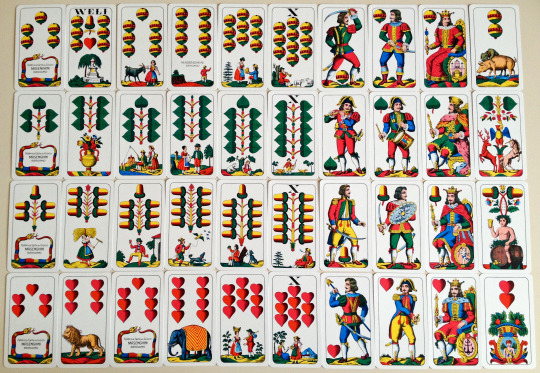
Salzburg pattern showing non-reversible court cards typical of earlier patterns, and Franconian pattern showing reversible ones, typical of later patterns
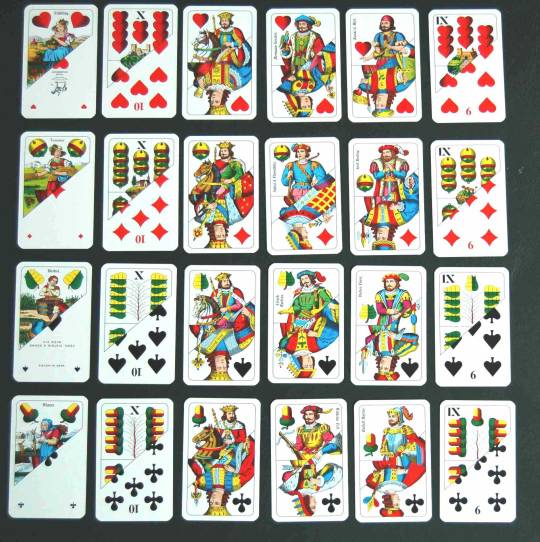
A hybrid deck showing both Germanic and French suits, in this instance the Germanic pattern is listed as William Tell and the French as Viennese
Italian patterns
Italian patterns closely resemble Mameluk and Spanish patterns, and it is in Italy where the polo baton of the Mameluk deck was replaced with a staff, or baton or club, for an area where polo was not well known or played.
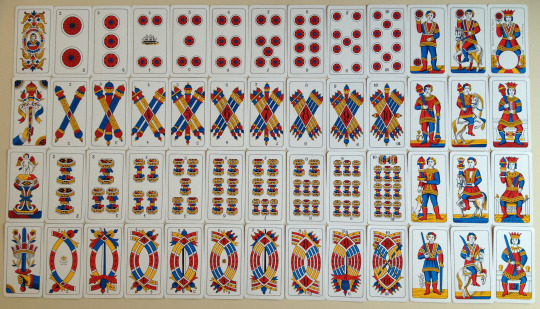
Trentine pattern, showing the Mameluk influence in both suits and court cards (King-Knight-Page)
In South Tyrol, a region acquired by Italy at the First World War, the Germanic Salzburg pattern is still used with Italian translations known as the Salisburghesi pattern.
It was in Italy that the first tarot decks were produced, where additional ‚trumps‘, known in Italian as trinofi, were added for more advanced card games. Typical to Northern Italy in the Italian suits, tarot cards for games such as Tarrochi, Tarock, and Scarto spread to France and Germanic areas whereupon there was further alterations made.
Tarot patterns
Tarot cards were never originally intended for Cartomancy, such associations came later in the 18th and 19th centuries, however there is a distinct split between Franco-Italian patterns and Germanic ones. A rare Italian deck serving as a progenitor of sorts to later 78-card tarot decks that now lost, was described in a letter from Milan in 1449 and supposedly consisted of a deck of 60 cards with only the four Kings as court cards, sixteen trump cards, and the suits as birds rather than any surviving system. Early 78-card decks replaced the court cards with classical figures and made the trump cards those of classical deities. Many of these early decks survive only as incomplete examples, damaged printing sheets, or in descriptions alone.
The Tarot of Marseilles is likely the first 78-card tarot deck to resemble the one we know today. The suits follow the Italian and Spanish patterns, synthesises the French and Spanish-Italian-Mameluk courts cards to give four in each suit: King-Queen-Knight-Page. The Major Arcana, or the trumps when ranked by value, are similar to modern tarot decks, albeit with some notable differences: the Magician is replaced by Le Bateleur (The Juggler), the High Priestess by Le Pances (The Popess, likely a reference to the myth of Pope Joan), and the Hierophant with Le Pape (The Pope). In Swiss tarot decks, the High Priestess is replaced by the classical deity Juno, and the Hierophant with Jupiter, in the style of the older historical Tarot de Besançon pattern.
Germanic tarot cards, however, are entirely different in nature. Trump cards in the Bourgeois Tarot pattern, with its sub-pattern the Tarot Nouveau, depict scenes rather than figures, and are split into groups of four (such as the times of day and the four elements), with the final three depicting Games (trump 20), the Collective (trump 21), and the Individual (trump 1)

Example Tarot Nouveau trumps, reversible but each scene depicting the card’s meaning

The trumps of the Industrie und Glück pattern, a standard tarot deck for games in the Germanic regions that uses the French suit system for value and court cards
One variation of tarot decks, known as Animal Tarot patterns, uses both real and fictional animals for the trump cards, and continues today only in the south German Adler Cego pattern
The End?
Honestly, this is all I have energy for at the moment, but I wanted to show just a hint of the huge variety of different playing card designs throughout the centuries and their effect on the modern decks of today. There is so much more I’d like to get into, so if you have some questions please please please ask!
36 notes
·
View notes
Text

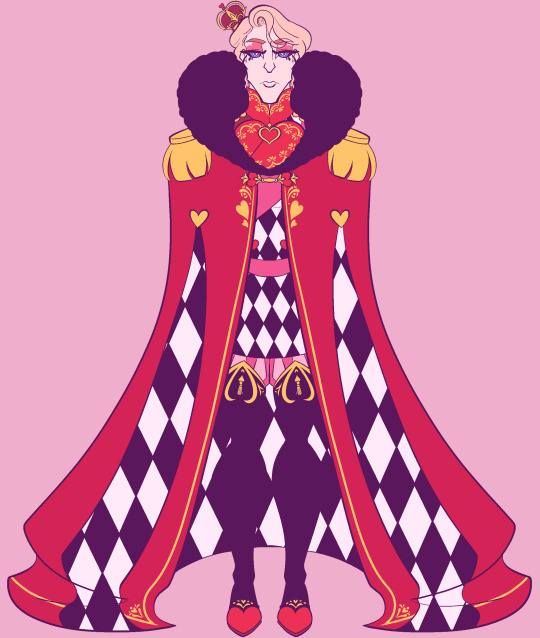
♥️ King of Hearts ♥️
The next one in my Cardverse redesigns, this time it's Luddy 🥺 I primarily based his design off of 19th century uniforms, though the animation "Queen Aluett" was also a HUGE inspo for me.
#hetalia#hws germany#ludwig beilschmidt#hws ludwig#hetalia germany#cardverse#cardverse germany#cardverse ludwig#hws cardverse#cardverse hetalia#dapp's art#my art#art#artists on tumblr#artists of tumblr#hetalia fanart#ヘタリア#ヘタリア world stars
37 notes
·
View notes
Text
i say this like every other month but i should go back and draw yuri of my wol aluette and sybil
6 notes
·
View notes
Photo

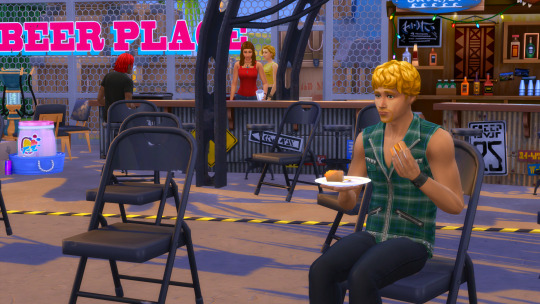
Edgewave Fest
[2 of 9]
#orghna#faune#savo#asher#aluette#kitani#olly#simpodia#simblr#edgewavefest#edgewavefest2023#the sims 4#sims 4#ts4#edgewave2023#edgewave 2023
21 notes
·
View notes
Text

Aluette card deck - Grimaud - 1858-1890 - Knight of Coins.jpg
2 notes
·
View notes
Photo

aluette wearing balmain 🎀🐰🎀
15 notes
·
View notes
Text
Day 13- check
Quill checked over his gunblade with great crutiny as he, Aluette, and their band of former Garlean conscripts sat around camp in Bozja.
"Honeybun, could you fix this up for me? There's some nicks in the blade and the leather is wearing a little thin on the handle."
"Of course, dear." Aluette smiled his way, "Oh, if you wouldn't mind Gin wanted to try using Dark Matter."
Quill passed over his blade, "I don't mind at all."
Aluette called the older Hyur woman over. Gin was a Nagxian conscript who, they found out only recently, loved to sew. Aluette explained the process for dark matter one last time before handing the blade over. "And bring it back to me so I can check it, okay?"
An hour or so went by uneventfully. Quill's repaired gunblade lay along side his leg, Aluette along his other side. He carefully tucked his journal away with one more day committed to its pages. Perhaps it was just about time to sleep.
Then a chirp sounded in his ear and a voice from one of their scouts followed,
"Captains, there is one group of imperials heading towards camp. I don't believe they know we are here yet. One machina, four soldiers, and one centurion."
They both stood up quickly and began commanding camp clean up.
Chester, a taller than average Lalafell, sighed, "I almost had Saw in check."
Saw, or Svetozar as they met him, picked Chester's poorly handcrafted chess pieces off a board of dirt. " I don't understand why you like that game so much." His voice was deep and thick with a Bozjan accent, "Or why you insist on challenging me."
"You're way too good at this for someone who doesn't even like it!" His eyes rolled as he took the pieces from Saw and put them in his satchel, "That's why!"
Aluette focused her gaze towards where the imperials should be and caught a glint of metal in the moonlight. "They're here."
Quill held his gunblade in his hands. "Everyone ready? Remember, we save those we can so all can return home." They charged.
#ffxivwrite2023#aluette verbena#quill verbena#and their gang of Garlean conscripts that i now want to make into retainers
2 notes
·
View notes
